Aegean Airlines Bundle
Who Really Owns Aegean Airlines?
Ever wondered who steers the ship at Greece's leading airline? Understanding the Aegean Airlines SWOT Analysis is just the beginning. This exploration of Aegean Airlines ownership dives deep into the company's structure, revealing the key players who influence its strategic decisions and financial performance.
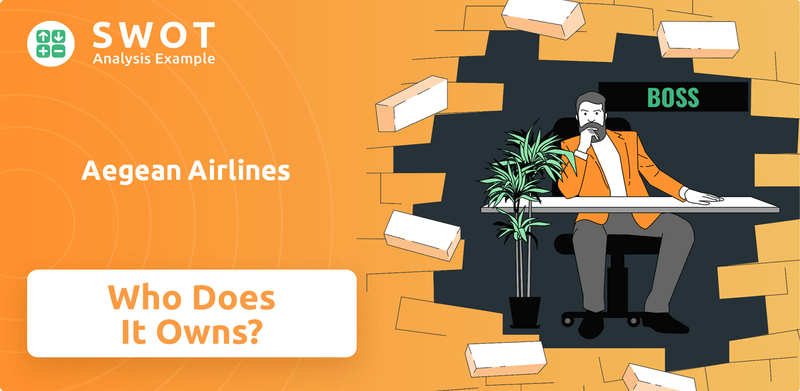
From its humble beginnings to its current status as a major player in the aviation industry, the Aegean Airlines story is one of strategic moves and evolving ownership. Knowing who owns Aegean Airlines, including the major shareholders and the influence of its parent company, provides crucial insights into its future trajectory. This knowledge is vital for anyone seeking to understand the airline's place in the competitive market, its relationships with partners like Lufthansa, and its overall strategic direction.
Who Founded Aegean Airlines?
The story of Aegean Airlines begins in 1987 with Antonios and Nicolaos Simidglades, who established Aegean Aviation as a private air-taxi service. This marked the initial step toward what would become a prominent player in the Greek aviation industry. The company's trajectory shifted significantly in 1994 when the Vassilakis Group acquired it, setting the stage for the airline's future development.
Under the leadership of Theodoros Vassilakis, the airline was rebranded as Aegean Airlines in May 1999. Vassilakis, a seasoned entrepreneur, aimed to build a high-quality airline that would offer superior service, contrasting with the perceived shortcomings of the state-owned Olympic Airways. His experience with the successful Greek Hertz franchise, Hertz-AutoHellas, provided a solid foundation for understanding and managing a large-scale operation.
Aegean Airlines officially launched scheduled flights in May 1999, starting with two new Avro RJ100 aircraft. The initial routes connected Athens, Heraklion, and Thessaloniki. The early strategy focused on expansion, with plans to grow the fleet. Strategic acquisitions quickly accelerated the airline's growth, establishing it as a major force in the Greek aviation market.
Aegean Aviation, founded in 1987 by Antonios and Nicolaos Simidglades, began as an air-taxi service. This early venture laid the groundwork for the future development of the airline. It was a crucial starting point.
In 1994, the Vassilakis Group acquired Aegean Aviation. This acquisition was a pivotal moment. It led to the rebranding of the company as Aegean Airlines in May 1999.
Theodoros Vassilakis, the founder and chairman, envisioned a high-quality airline. His goal was to provide superior service. This was in contrast to the perceived issues with Olympic Airways.
Aegean Airlines commenced scheduled flights in May 1999. The initial operations included flights between Athens, Heraklion, and Thessaloniki. The airline started with two Avro RJ100 aircraft.
Aegean Airlines quickly expanded through acquisitions. In December 1999, it acquired Air Greece. This made the combined entity the second-largest airline in Greece. Further expansion occurred in 2001 with the merger with Cronus Airlines.
Within a year of starting operations, the airline had a fleet of 16 aircraft. The acquisitions of Air Greece and Cronus Airlines significantly increased the size of the fleet. This rapid growth was a key part of their strategy.
Understanding the early ownership structure of Aegean Airlines provides insight into its rapid growth and strategic direction. The Vassilakis Group's acquisition and the subsequent mergers highlight a focused approach to expanding market share. While specific initial shareholding details are not publicly available, the actions taken by the company demonstrate a clear vision for the future. For more insights into the competitive environment, you can explore the Competitors Landscape of Aegean Airlines.
- The initial founders were Antonios and Nicolaos Simidglades, who started the company as Aegean Aviation.
- The Vassilakis Group acquired the company in 1994, which led to its rebranding as Aegean Airlines.
- Theodoros Vassilakis, the founder and chairman, played a crucial role in shaping the airline's vision.
- Strategic acquisitions, such as Air Greece and Cronus Airlines, accelerated the airline's growth.
Aegean Airlines SWOT Analysis
- Complete SWOT Breakdown
- Fully Customizable
- Editable in Excel & Word
- Professional Formatting
- Investor-Ready Format
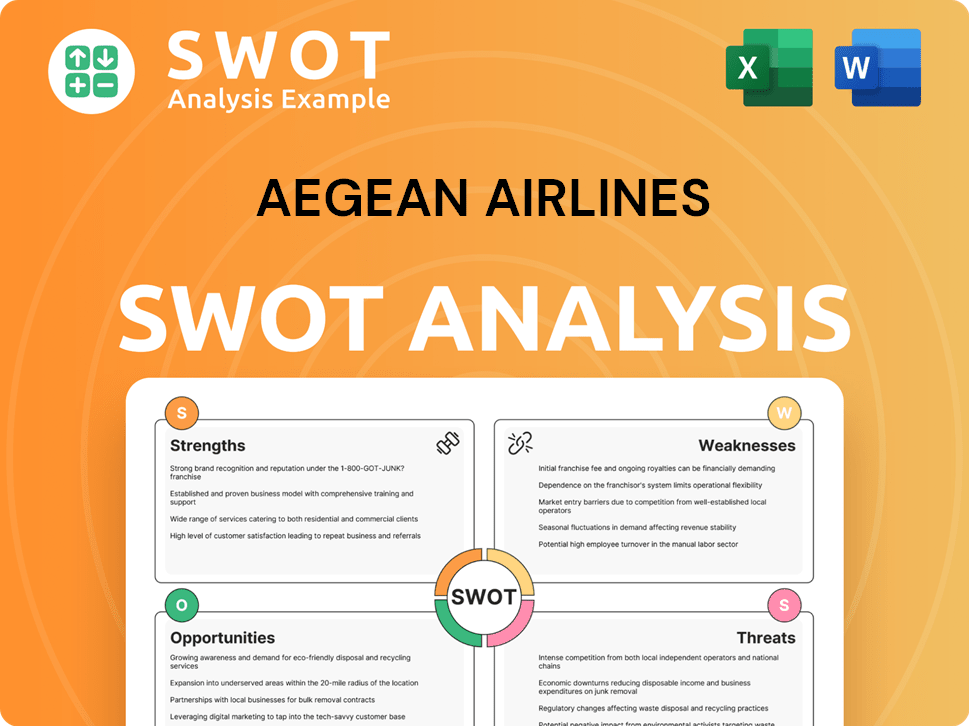
How Has Aegean Airlines’s Ownership Changed Over Time?
The ownership structure of Aegean Airlines has seen significant changes since its inception. A pivotal moment was the initial public offering (IPO) in July 2007, making it the first Greek airline to list on the Athens Stock Exchange. The IPO offered 25% of the company's stock, raising approximately €125 million, with shares priced at €7.60 each. The company's share capital is €58,608,615, divided into 90,167,100 common voting registered shares, each with a par value of €0.65. This event marked a crucial step in the airline's journey, influencing its growth and strategic direction.
Another key development was the acquisition of Olympic Air in October 2013. This merger, approved by the European Commission, solidified Aegean's position as Greece's leading airline, significantly impacting its market share and network. These strategic moves have shaped the company's governance and allowed for expansion, particularly in the Greek domestic market, where the Aegean Airlines Group held 54% of seats in 2024. Understanding the evolution of Aegean Airlines ownership is crucial for grasping its strategic direction and market position.
| Shareholder | Percentage of Equities | Valuation (approximate) |
|---|---|---|
| Estate of Theodore Eftichiou Vassilakis | 24.9% | €291 million |
| Autohellas SA | 11.84% | Not Available |
| Other Institutional Investors | Various | Not Available |
As of the latest available information, the major shareholders of Aegean Airlines include the Estate of Theodore Eftichiou Vassilakis, holding 24.9% of the equities, valued at €291 million. Autohellas SA holds 11.84%. Other significant institutional investors include The Vanguard Group, Inc., Piraeus Asset Management Single Member Mutual Funds Management Company S.A., Pension Mutual Fund Management Company S.A., BlackRock, Inc., Eurobank Mutual Fund Management Co., Mirae Asset Global Investments Co., Ltd., and Alpha Trust Mutual Fund Management Co. Eftichios Vassilakis holds 37.50% of the voting rights, and ALNESCO ENTERPRISES COMPANY LTD holds 12.02%. For more details, you can read about the Brief History of Aegean Airlines.
The ownership structure of Aegean Airlines is a blend of strategic investments and institutional holdings.
- The IPO in 2007 was a pivotal moment, raising significant capital.
- The acquisition of Olympic Air in 2013 strengthened its market position.
- Key shareholders include the Estate of Theodore Eftichiou Vassilakis and Autohellas SA.
- Understanding the major shareholders helps to understand Aegean Airlines owner and its strategic decisions.
Aegean Airlines PESTLE Analysis
- Covers All 6 PESTLE Categories
- No Research Needed – Save Hours of Work
- Built by Experts, Trusted by Consultants
- Instant Download, Ready to Use
- 100% Editable, Fully Customizable
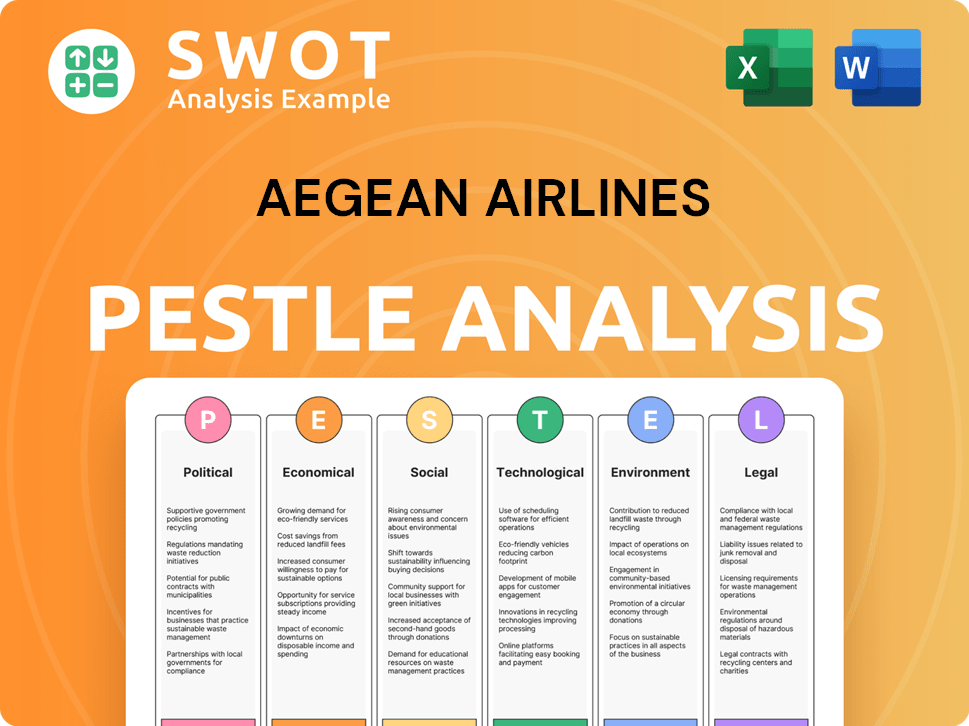
Who Sits on Aegean Airlines’s Board?
The current Board of Directors of Aegean Airlines, elected for a three-year term as of April 30, 2024, oversees the company's strategic direction and governance. The board is composed of executive and non-executive members, including representatives from major shareholders and independent directors. This structure aims to balance operational expertise with independent oversight, influencing the company's decisions and ensuring accountability.
The board's composition reflects a mix of experience and perspectives, crucial for navigating the complexities of the airline industry. The presence of independent directors is particularly important for maintaining objectivity and adhering to corporate governance best practices. This structure is vital for the long-term success of the company, ensuring that decisions are made in the best interests of all stakeholders. Understanding the Aegean Airlines company information is key for investors.
| Board Member | Title | Role |
|---|---|---|
| Eftichios Vassilakis | Chairman | Executive Member |
| Anastasios David | A' Vice Chairman | Non-Executive Member |
| Panagiotis Laskaridis | B' Vice Chairman | Non-Executive Member |
| Dimitrios Gerogiannis | CEO | Executive Member |
| Stella Dimaraki | Executive Member | Executive Member |
| George Vassilakis | Non-Executive Member | Non-Executive Member |
| Konstantinos Kalamatas | Independent Non-Executive Member | Independent Non-Executive Member |
| Achilleas Constantakopoulos | Non-Executive Member | Non-Executive Member |
| Nikolaos George Nanopoulos | Non-Executive Member | Non-Executive Member |
| Natalia Nikolaidis | Independent Non-Executive Member | Independent Non-Executive Member |
| Alexandra Papalexopoulou | Independent Non-Executive Member | Independent Non-Executive Member |
| Nikolaos Sofianos | Independent Non-Executive Member | Independent Non-Executive Member |
The voting structure at Aegean Airlines generally follows a one-share-one-vote system. Eftichios Vassilakis holds a significant portion of voting rights, at 37.50%, indicating the strong influence of the founding family. ALNESCO ENTERPRISES COMPANY LTD also holds a notable 12.02% of voting rights. The presence of independent non-executive members, particularly in committees like the Remuneration & Nominations Committee, is designed to ensure objective oversight. There have been no recent proxy battles or activist investor campaigns that have significantly altered the company's decision-making structure.
Understanding the ownership structure is vital for investors and stakeholders. The board's composition, including independent directors, ensures oversight.
- Eftichios Vassilakis has a significant voting power.
- ALNESCO ENTERPRISES COMPANY LTD also holds a notable percentage of voting rights.
- Independent directors ensure objective oversight and adherence to corporate governance.
- The company's structure aims to balance operational expertise with independent oversight.
Aegean Airlines Business Model Canvas
- Complete 9-Block Business Model Canvas
- Effortlessly Communicate Your Business Strategy
- Investor-Ready BMC Format
- 100% Editable and Customizable
- Clear and Structured Layout
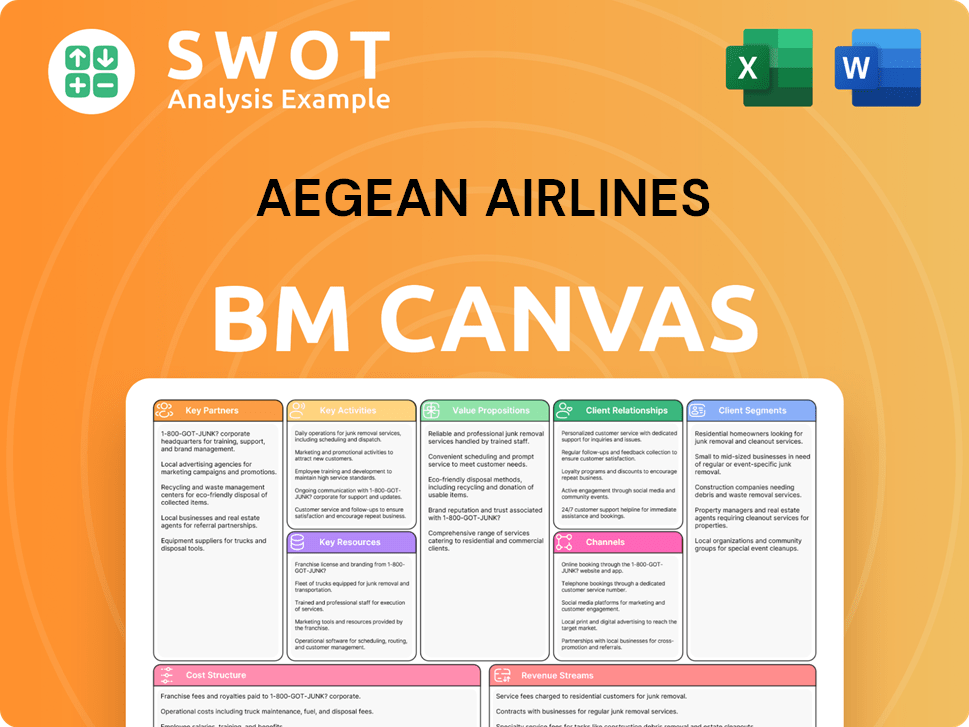
What Recent Changes Have Shaped Aegean Airlines’s Ownership Landscape?
Over the past few years, Aegean Airlines's performance has remained strong, alongside strategic investments. In 2024, the airline achieved record revenue of €1.78 billion and transported 16.3 million passengers, marking a 5% and 6% increase, respectively, compared to 2023. The net profit for 2024 was €129.9 million. The company's liquidity is robust, with cash equivalents and other financial investments totaling €796.1 million as of March 31, 2025.
A notable development in the ownership trends involves the investment in the Spanish low-cost airline, Volotea. In 2024, Aegean Airlines invested €25 million in Volotea through a profit-participating loan convertible into shares, increasing its total investment to €31 million. The airline aims to increase its stake in Volotea from the current 13% to 21%, with discussions expected to conclude by June or July 2025, potentially involving a further €25 million investment. This strategic move aligns with industry consolidation trends and strategic partnerships, enhancing market positioning. This is a key aspect of understanding the Aegean Airlines ownership structure.
| Metric | 2023 | 2024 |
|---|---|---|
| Revenue (€ billion) | 1.69 | 1.78 |
| Passengers (millions) | 15.4 | 16.3 |
| Net Profit (€ million) | 115.6 | 129.9 |
Aegean Airlines continues its fleet renewal program, with 6 aircraft deliveries scheduled for 2025, including 3 Airbus A321neo, 2 Airbus A320neo, and one ATR 72-600. The company is also expanding its network with new routes and is investing in a new Maintenance & Training Center. These investments demonstrate a commitment to long-term growth. The Board has proposed a dividend of €0.80 per share for 2024. The company's management is committed to investing in winter development to mitigate seasonality.
The ownership structure of Aegean Airlines involves major shareholders and potentially a parent company, influencing its strategic decisions and financial performance. Understanding the key stakeholders is crucial for assessing the company's direction. The airline's history has shaped its current ownership profile.
The management team and key personnel play a vital role in the company's operations and strategic initiatives. Knowing who is the CEO of Aegean Airlines and other key figures provides insights into the airline's leadership and decision-making processes. The board of directors also significantly influences company strategy.
Aegean Airlines's partnerships, such as its membership in Star Alliance and its relationship with Lufthansa, impact its market reach and operational capabilities. These alliances are important for understanding the airline's strategic position in the industry. The company profile includes details of these partnerships.
Analyzing Aegean Airlines's financial performance, including its revenue, profit, and stock ownership, provides insights into its financial health and market position. Is Aegean Airlines publicly traded? Understanding the company's financial data is essential for investors and stakeholders. The company information is readily available.
Aegean Airlines Porter's Five Forces Analysis
- Covers All 5 Competitive Forces in Detail
- Structured for Consultants, Students, and Founders
- 100% Editable in Microsoft Word & Excel
- Instant Digital Download – Use Immediately
- Compatible with Mac & PC – Fully Unlocked
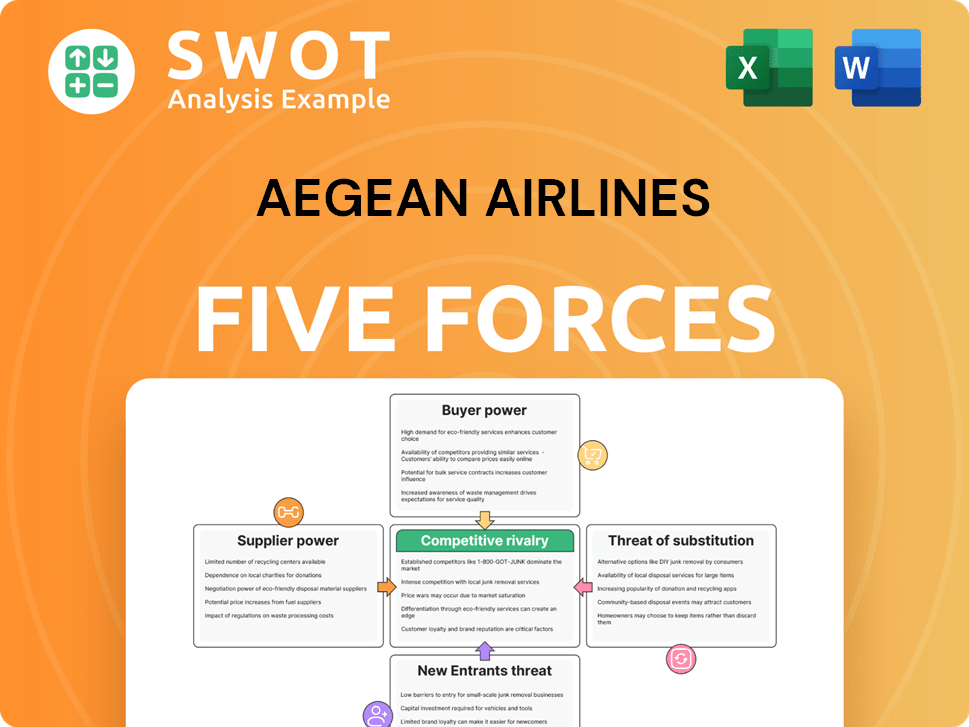
Related Blogs
- What are Mission Vision & Core Values of Aegean Airlines Company?
- What is Competitive Landscape of Aegean Airlines Company?
- What is Growth Strategy and Future Prospects of Aegean Airlines Company?
- How Does Aegean Airlines Company Work?
- What is Sales and Marketing Strategy of Aegean Airlines Company?
- What is Brief History of Aegean Airlines Company?
- What is Customer Demographics and Target Market of Aegean Airlines Company?
Disclaimer
All information, articles, and product details provided on this website are for general informational and educational purposes only. We do not claim any ownership over, nor do we intend to infringe upon, any trademarks, copyrights, logos, brand names, or other intellectual property mentioned or depicted on this site. Such intellectual property remains the property of its respective owners, and any references here are made solely for identification or informational purposes, without implying any affiliation, endorsement, or partnership.
We make no representations or warranties, express or implied, regarding the accuracy, completeness, or suitability of any content or products presented. Nothing on this website should be construed as legal, tax, investment, financial, medical, or other professional advice. In addition, no part of this site—including articles or product references—constitutes a solicitation, recommendation, endorsement, advertisement, or offer to buy or sell any securities, franchises, or other financial instruments, particularly in jurisdictions where such activity would be unlawful.
All content is of a general nature and may not address the specific circumstances of any individual or entity. It is not a substitute for professional advice or services. Any actions you take based on the information provided here are strictly at your own risk. You accept full responsibility for any decisions or outcomes arising from your use of this website and agree to release us from any liability in connection with your use of, or reliance upon, the content or products found herein.